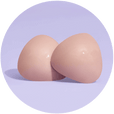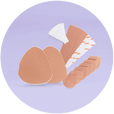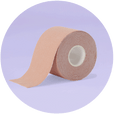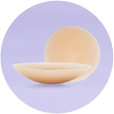From red carpets to everyday wear, boob tape has found its way into the wardrobes of many women.
It's become a go-to solution for an array of outfits, no matter the size or shape of your breasts. But you might not realize there's more to it than just strategically layering some tape over your breasts.
To keep your skin and breasts healthy, there are essential steps you should be taking both before and after you wear boob tape. This will help you minimize skin irritation and keep up the fight against sagging skin. Here, we'll share our best tips.
What Is Boob Tape?
Boob tape — a secret weapon for many fashion-conscious individuals — serves to lift, shape, and enhance the appearance of your breasts without requiring the use of a traditional bra. It's a highly versatile tool that allows for multiple application techniques, making it adaptable for various dress styles, including backless dresses and plunging necklines, and providing cleavage support for those wearing bras of any size, including large busts.

Before Using Boob Tape
Do you want to look after the health of your skin and boobs? Let's review some best practices for preparing to use boob tape.
Prepare Your Skin
Getting ready for the boob tape application is crucial for ensuring the tape adheres correctly and stays put. But prepping your skin also ensures you're not trapping any would-be irritants against your skin for the duration of wear.
Begin by ensuring your skin is 100% clean and dry. Wash the area with a mild, alcohol-free soap, then pat it dry or allow your skin to air dry. Ensure your skin is free of oils or lotions, which could interfere with the adhesive.
Avoid applying boob tape on sunburned, irritated, or delicate skin.
Preparing your skin correctly also includes applying nipple covers. This will protect your most sensitive areas underneath the tape, and it will prevent damage to your nipples during the removal of the boob tape.
Plan Your Application
Your goal is to use only as much tape as you need to achieve the lift and support you want for perkier boobs. Layering excess boob tape on your breasts and chest area could trap excessive moisture (sweat) on your skin and increase your chances of skin irritation. Therefore, it is beneficial to map out your application ahead of time.
Boob tape application techniques can vary depending on the outfit you're intending to wear. To create a lift effect, begin the application from the base of the breasts, extending it upwards. Position the tape over your chest for plunging necklines, mimicking the design of suspenders.
Ideally, you're using a tape specific for this purpose and can refer to the brand's instructional materials for various techniques.
While some women may use alternatives, such as gaffer's tape, if you're concerned about skin sensitivities, it's much safer to choose a tape specifically for taping breasts. Look for a product like Nueboo Boob Tape, which is strong, waterproof, and guaranteed to last for up to 8 hours.

After Using Boob Tape
Caring for your skin after using boob tape is crucial if you want to maintain the health of your skin, and it starts with the careful removal of the boob tape itself.
Remove the Boob Tape Gently
Choose a time when you are unhurried, unstressed, and can take your time. To make the experience as gentle as possible on your skin, apply baby oil or coconut oil with your fingers to the edges of the tape. Allow it to sit for 5-15 minutes to dissolve the adhesive.
When you're ready, hold your skin taut with one hand. With the other, grasp the edge of the tape and begin to lift and peel it back slowly and gently. By supporting your skin with one hand, you are preventing it from stretching, which is one of the culprits behind sagging skin.
Repeat until you've removed every piece of tape. Then, repeat the entire process on a smaller scale to remove your nipple covers as well.
Cleanse & Hydrate Your Skin
Rub oil all over your application area to eliminate persistent adhesive traces. Then, clean your skin with a mild soap, careful not to scrub it.
Rinse your skin and let it air-dry completely or pat yourself dry. Finally, apply a nourishing moisturizer to rehydrate and calm your skin. This will facilitate healing, so your skin stays nourished and ready for another application.
Frequently Asked Questions
What are the disadvantages of using boob tape?
Using boob tape for periods longer than 8 hours can potentially elevate your risk of skin irritation or injury. This is because the skin may overheat, leading to adverse reactions to the adhesive.
What are the potential side effects of boob tape?
Boob tape's adhesive could potentially lead to side effects like redness, itching, or skin rashes. Testing a small skin patch before completing the application is always wise. Improper or forcible removal of boob tape may cause discomfort and skin irritation.
Can I swim while wearing boob tape?
Yes, you absolutely can swim while wearing boob tape! There are waterproof boob tapes that will ensure you can confidently enjoy your swimming experience while maintaining a stylish look.
What alternatives exist to boob tape?
Sticky bra inserts are a great alternative if you prefer not to use boob tape. They add volume, enhance your cleavage, and help shape your boobs with no visibility. For individuals with smaller chests, this is a great way to improve your bust without a bra or surgery.






0 comments